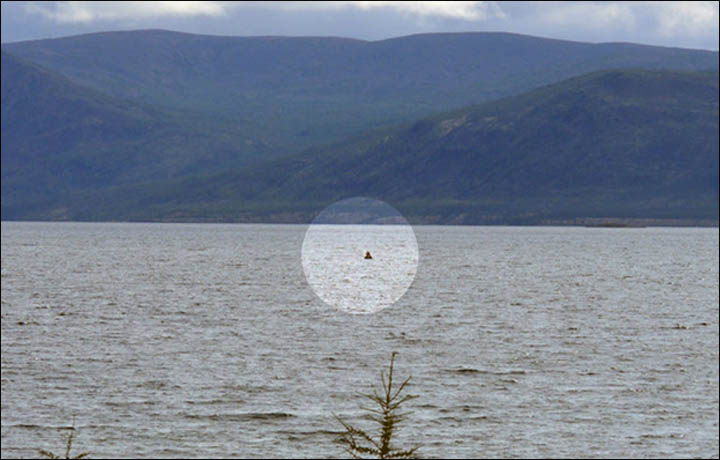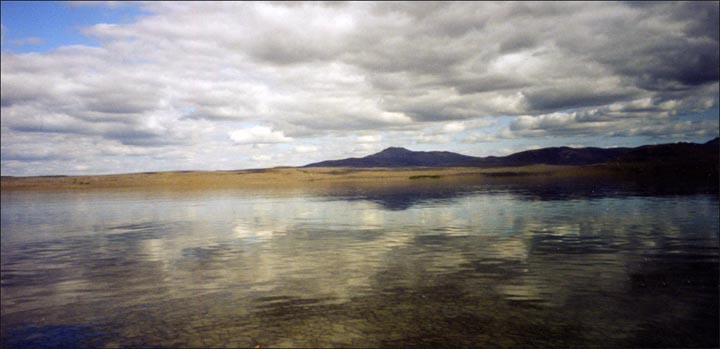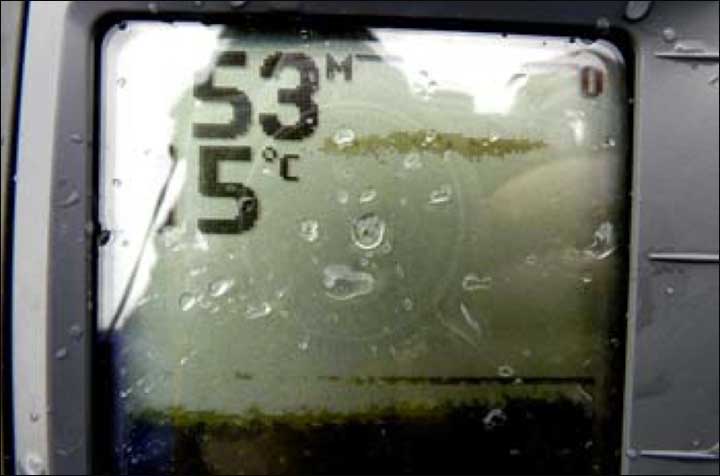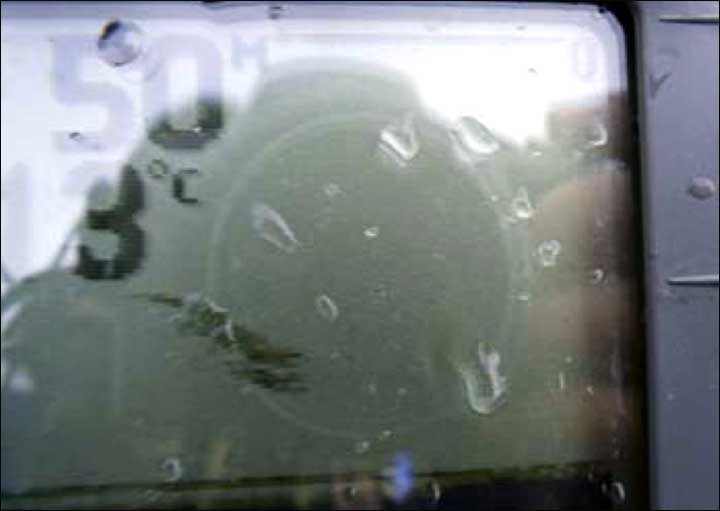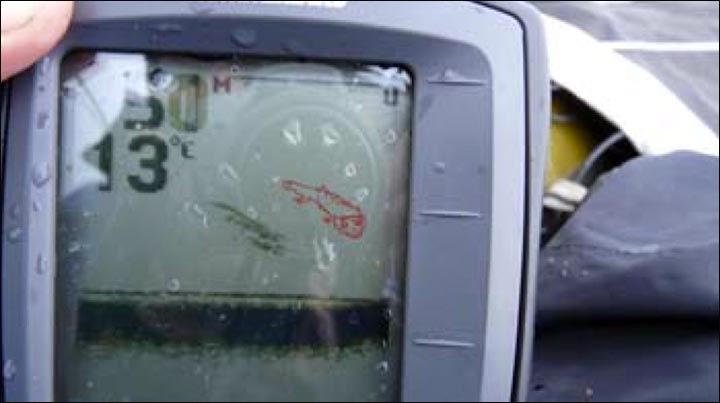Probable tail fin of a diving sturgeon: top part of tail seems to show the armour plates
 http://english.pravda.ru/science/mysteries/06-08-2007/95690-strange_monsters-0/
http://english.pravda.ru/science/mysteries/06-08-2007/95690-strange_monsters-0/
Mysterious water mammoths inhabit Siberian lakes
06.08.2007
The Russian media has recently reported on a huge monster with the head of a serpent and the body of a crocodile lurking at the bottom of a lake near the village of Somin in Western Ukraine.
The lake is 56 meters deep. A number of underwater karst caves stretch its bottom. That is where the mysterious monster lies in wait, according to locals. As a rule, locals steer clear of the lake because they are said to have been terrified by the hideous creature hiding
underwater. It reportedly attacked domestic animals in the past. Some 30 years ago a local groom fell prey to the monster, according to one of the stories circulating through the village. The groom got drunk and fell fast asleep in the grass near the shore. The monster reportedly crept out of the water and had the groom for lunch. Another creepy story features a disobedient boy who decided to take a swim in the lake. Needless to say, the boy has never come back home or so the story goes.
[The "Crocodile" reports come from all over European Russia and, as we shall see, in far Eastern Siberia as well. There is a chance that the European reports do refer to giant salamanders also. The head is wrong for the reference to be to fishes like pikes because the heads are broad, flattened and blunt like snake's heads-DD]
The news from Ukraine caused quite a stir in the Russian media. One of the Russian TV stations was even planning to make a film about a “new Nessie.” A naïve person might have expected hordes of zoologists heading for Ukraine from all over the world. However, nothing of the kind happened. Scientists are well-aware of the laws of genetics, which say that a population of large vertebrates must comprise a minimum of 300-500 species in order to survive. Would they have had enough room in Lake Somin, whose total area is about 6 hectares? Besides, they would have long eaten up all the fish in the lake. Plenty of fish still occur in the lake. Several cat fishes caught in the lake reportedly measured up to two meters in length. The legend of the lake monsters seems to stem from one of the local fish stories. [Catfishes would not have legs and would not be amphibious]
Several dozen similar lakes scattered around the former Soviet Union are claimed to have monsters, which scientists still have to identify. Some of the cases on record are made up of pure mystification and rumors; others may contain some grains of truth.
Bogus monster getting publicity
Lake Khainyr is located in Yakutia, outside the Polar Circle. The lake is very small, measuring 500 by 600 meters, and quite shallow, about 7 meters deep. The lake is of termokarst origin; it is actually a thawed patch in the permafrost. In 1964, Komsomolskaya Pravda published an article featuring an interview by G. Rukosuyev, head of the Northeastern Expedition of the
Moscow State University. The scientist cited an account by one N. Gladkikh, a migrant worker hired by the expedition. Gladkikh claimed to have run into a lake monster on a misty early morning. The worker was about to draw some water from the lake when he spotted an unusual water creature lying on the shore. He provided Rukosuyev with the following description of the animal:
“It had a long gleaming neck with a small head. Its body was huge, covered with black-blue skin. There was a big dorsal fin on the back of its body. All of sudden, the animal slid back into the water. Some time later I saw it standing out the water in the middle of the lake. The animal started swinging its long tail to whip the water. The waves were rippling the surface of the lake.”
Aside from citing the “eyewitness account,” Rukosuyev also threw in a few other pieces of information to add color to the story. For instance, he claimed that there was no fish in the lake and birds had never landed on its surface. He also referred to some “muffled sounds and splashes of water” frequently heard by locals.
An expedition was dispatched to the location to investigate the case. As a result, the whole story proved to be a fake. Researchers found out that birds did land on the surface of the lake, which had a lot of fish swimming in its waters. None of the locals had ever seen any strange animals in the lake. Scuba divers combed the bottom of the lake but found nothing strange.
Researchers also had a heart-to-heart talk with Gladkikh, the so-called eyewitness. Gladkikh admitted that he had made up his story for reasons he could not clearly explain. He concocted it either to entertain himself and his friends or as an excuse for shirking his duties at work.[There is a good chance that Gladkikh saw a moose grazing at the shore and then plunging into the water, and embroidered the story to make it sound like a prehistoric animal had been there. Part of the original story had been that it was eating the grass on shore-which is a very peculiar and significant allegation. and the "Fin" on its back could be a reference to the hump on the moose's back.-DD]
Little water goblins hiding at the bottom of Lake Vedlozero
Karelia is well-known for its numerous lakes, which are amazingly blue in color and rich in fish. Lake Vedlozero looks like a typical Karelian lake. It is 15 km long and about 7 km wide. The lake is of glacial origin. A large village sits on its left banks. The first reports of the Vedlozero appeared in the mid-1990s. One of the reports quoted the late P. F. Yegorov, a local old-timer who claimed he had seen a large shining object fall into the lake from the sky. However, nothing was found at the bottom of the lake by members of several expeditions. However, Viktor Sapunov, a cryptozoologist who took part in one of the missions, later published a report based on accounts provided by local residents who claimed to have seen “water goblins” in the lake. The mysterious midget men with rounded heads were somehow associated with the fall of the “heavenly body” in the lake
Our team arrived in the location last fall. We asked around several old residents of the village. None of them saw any “water goblins” in or near the lake. Some people recalled spotting seals in the lake on several occasions. “I go fishing on a regular basis. I have never seen any ‘water goblins’ in our lake. I have never heard about them. As for the seals, they drop by the lake now and then. One of the locals even caught a seal several years ago. He carried a camera on that day so he took a picture of the animal. There is nothing strange about seals coming down the lake. Lake Ladoga is not so far away from here. They just travel to and fro through the tributaries,” said Vasily Efremov, head of the village council.
Efremov’s explanation seems quite logical. City guys who went fishing in Lake Vedlozero may have spread the rumors about the “water goblins” after noticing seals in the lake. Any diver will agree that that seals in the water can be easily taken for humans. Besides, Lake Ladoga is located in close proximity to
Lake Vedlozero. Perhaps the territory populated by seals or other species of freshwater pinniped animals in Russia was much wider in the past. The assertion could explain quite a few Russian legends of mermaids and water goblins.
[See also
http://forteanzoology.blogspot.com/2010/02/dale-drinnon-ugly-mermen.html ]
Hairy monsters snorting at fishermen
A large number of lakes scattered around the vast territory of Northwest Siberia are the lakes that vary greatly in size and shape. They lie in the swampy taiga and forest tundra. Many of them are connected to one another via tributaries.
 |
| Ityrsh Basin (River in purple) |
Professor N. Vereshchagin, a zoologist and self-proclaimed “fighter against “the snowman buffs,” recently published an article, in which he ironically quoted one of the letters addressed the Institute of Zoology. Prof. Vereshchagin poked fun at the letter’s author who maintained that either seals or hippopotamuses lived in some of the lakes in the Irtysh basin. However, some enthusiasts of cryptozoology refrain from making a mockery of similar reports. They opt to check them first. The late Maya Bykova, one of the first “snowman buffs” in this country, made several trips to the area. She put down a number of eyewitness accounts; most of them read more or less like this:
“I was rowing my boat across the lake when I heard that splash. The sound of it made me stop. I was wondering what kind of a fish could have splashed like that. I lifted the oars and peered in that direction.
The next moment I saw something big emerge from the water, it looked like a haystack rising to the surface. I looked on and saw that the creature was covered with fleecy dark-brown skin resembling that of a seal. It made a hissing sound and dived back into the water.”
Other eyewitness accounts recorded by Bykova contain a similar description of the “monster:” creatures covered with fleecy dark-brown skin quickly rise to the surface, force air violently out through their noses and go back into hiding.
We are quite pleased to emphasize a few important things with regard to the above case as we look at it with the laws of nature in mind. First, the incidents did not take place in a single lake shut away from the rest of the world. On the contrary, the monsters have been seen in several bodies of water, which are frequently connected by means of tributaries. And those lakes are scattered over the vast and sparsely populated area. There is enough room for thousands of species to live virtually unnoticed by anybody. Second, animals can get enough food to survive and multiply. And, last but not least, any visual contact is most likely to involve local villagers who are very few in numbers, hence a sharp decrease in the possibility of a chance meeting. Besides, locals are not used to reporting their observances to the Academy of Sciences. Given a rather skeptical stance on the phenomenon among members of science community, such a letter would be either ignored or laughed at.
The question is: What are those mysterious creatures? Their fleecy skins indicate that they are warm-blooded mammals… In my opinion, they could belong to some unidentified species of pinniped animals, freshwater seals. If some seals can live in Lake Ladoga and Lake Baikal, what is so strange about other seals populating in other freshwater bodies of water?
Other theories look pretty weird, to say the least. One of them has gained lots of popularity recently. According to the theory, the lake monsters are mammoths which turned into aquatic animals for reasons unknown. The theory is simply preposterous because mammoths had very few sebaceous glands under the skin, and therefore their long hair could get easily wet. A similar theory put forward by N. Avdeyev, a cryptozoologist from the city of Perm, features relic wooly rhinoceroses which somehow managed to survive. The latter theory does not seem so foolish, compared to the “
water mammoths” of the former one. Still, it can hardly hold any water either.
[Although the Freshwater seal theory is suggested, these "Hippopotamuses" are much too large, bulky and shaggy to be seals. They are referred to in legends from the Ukraine and the Urals right across to the mountain lakes of Mongolia. The name should be looked at as the direct translation of the Greek, "River Horses" (or Water Horses) and there is some Archaeological representation of such Water Horses from all over European Russia. The name in some places is "Water Cows and Water Bulls" and Eberhart records the legend in passing in the appendix to Mysterious Creatures. All of these terms (Water horses, cows or bulls) are commonly used to refer to elk (moose) in some locations (if not generally) and there can be little doubt that the references are actually to swimming elk (moose) once again. There is at least one obvious report of this type also at Lake Labynkir-DD.]
Komsomolskaya Pravda
Translated by Guerman Grachev Pravda.ru
http://frontiersofzoology.blogspot.com/2012/09/so-is-there-loch-ness-monster-in-siberia.html
A Loch Ness Monster discovered in Siberia?
Description: “Hoding stood erect and whirled his axe up against the descending muzzle”
Attribution: Illustration by E.L. Blumenschein for “Thyra: A Romance of the Polar Pit” by Robert Ames Bennet (1901)[at Project Gutenberg]
Fictionalised account of the legendary "Siberian Crocodile", more likely a harmless relative of the Japanese Giant Salamander. The Legendary beast is said to be a sort of dragon which guards Treasure in the form of Mammoth ivory and rumours of it have been filtering back to Europe since the 1700s. The artwork looks as if the artist was also thinking of Giant pike.
By The Siberian Times
reporter
A Moscow scientist is calling for a new scientific expedition to solve the
mystery of a huge 'monster' claimed to be living in remote Lake Labynkyr in
Siberia.
Probable back fin of sturgeon sticking up out of the water
Is this the Siberian Nessie...?
Known as 'Russia's Loch Ness Monster', the accounts of the
creature in Yakutia predate the Scottish claims yet in many ways are
similar.
Intriguingly, too, there are theories that Labynkyr - which has unusual
cracks on its 60 to 80 metre deep floor - is connected by underwater channels
to another lake, Vorota, where monster sightings have also been
recorded, including by respected Soviet geologist Viktor Tverdokhlebov, an
academician not given to hyperbole.
Associate Professor of Biogeography Lyudmila Emeliyanova revealed to The
Siberian Times that on her own scientific mission to Labynkyr she recorded
'several seriously big underwater objects' with sonar readings.
She is not the only researcher to have done so.
'It was our fourth or fifth day at the lake when our echo sounding device
registered a huge object in the water under our boat,' she said.
'The object was very dense, of homogeneous structure, surely not a fish nor a
shoal of fish, and it was above the bottom. I was very surprised but not scared
and not shocked, after all we did not see this animal, we only registered a
strange object in the water. But I can clearly say - at the moment, as a
scientist, I cannot offer you any explanation of what this object might be.'
Lyudmila Emelyanova, Moscow State University Associate Professor of
Biogeography working with echo sounding device during her expedition to Labynkur
lake in Yakutia. Picture: Andrei Emelyanov
The readings were repeated and she became convinced there was more than one
large living object in the pure waters.
'I can't say we literally found and touched something unusual there but we
did register with our echo sounding device several seriously big underwater
objects, bigger than a fish, bigger than even a group of fish.
'This is why I fully support the idea of a new trip there and extra
research.
'I would love to take part in another visit to this lake. I know how to
organise it and know enough good local people who can help on the spot. It is a
hard trip I must say but it is definitely worth doing it again. This mysterious
and very deep lake still has some secret to tell us.'
Freshwater Labynkyr, some 5,000 km east of Moscow, is mysterious for another
reason, too. It is only around 60 kilometres from the settlement of Oymyakon -
the coldest inhabited place on Earth - yet, astonishingly, the lake does not
freeze over completely in winter, in contrast to virtually all lakes in the
region. The ice that does form, unusually, can be too thin to walk on. It is
not uncommon to driver cars on lakes in Yakutia in winter: but not Labynkyr.
One unproven theory is that Labynkyr, where much of the rock is volcanic, is
warmed slightly from below by a fissure in the Earth's crust.
Dr Emeliyanova, from the Biogeography Department of the Geographical Faculty
of Moscow State University, is struck by historical accounts of
monsters in Labynkyr and Vorota and believes they are credible.
They date from the late 19th century, while accounts of the Loch Ness
monster are usually held to have emerged in the 1930s.
Labynkyr lake, Yakutia. Picture: Andrei Emelyanov
On the basis of 'sightings' there has been speculation that Labynkyr and
Vorota might be inhabited by a school of ichthyosaurs, prehistoric marine
reptiles resembling dolphins or sharks, or plesiosaurs, a popular theory
concerning 'Nessie' in Scotland which is often depicted with a long neck.
Another version has speculated that relic killer whales could have become
marooned in Labynkyr. Some accounts even suggest the 'creature' makes a hideous
primeval cry as it attacks its prey.
'Personally, I do believe that when the information about something strange
circulates among local people for so many years, it just can't be groundless, it
means something is there,' she said. 'I know the local people very well - they
are ingenuous but they do not lie,' she said previously.
Now she adds: 'I have been on a dozen expeditions to this region and I can
say I know the character of local people quite well. They are emotional - but
are not intended to show their emotions and they are very true and honest by
nature, often more honest than is necessary. This is why I am not ready to
reject all these stories.'
For her another factor is how the stories of monsters in Yakutia
relate solely to these two lakes out of more than 800,000 across this giant
region.
'There are many lakes in Yakutia and around the Indigirka River, hundreds of
them, big and small, their shores are more or less populated, but all the talk
is about Labynkyr and Vorota lakes, and it has gone on for many dozens of years.
It makes us think about it. And these stories about the local
monster are older than those about the Loch Ness
monster.'

Lyudmila Emelyanova, Moscow State University Associate Professor of
Biogeography with her team on way to Labynkur lake in Yakutia. Pictures: Andrei
Emelyanov
Even so, she insisted of her 2002 trip: 'I did not go there to chase the lake
monster: as a biogeographer I was interested mainly in that very
territory, I wanted to visit and study it.
'But, of course, I was curious to see the place which has so many legends and
stories. I did not suppose we could really find something there simply because
we did not plan to spend there enough time. Our stop by the lake was just for 12
days.
'As a scientist I know this is not enough to locate and study some unknown
creature. I can put it like this, however. I believe there is a mystery in this
lake because there is no smoke without fire.
'I am sure that numerous legends which exist and circulate for many years
just can't be groundless. I read many different legends but the account below is
what I heard with my own ears.
'Several fishermen who visit this lake from time to time say they experienced
the following when fishing from a boat in this lake: during quiet, and not
windy, weather when there were no disturbances in the lake, some strange waves
coming from under the water suddenly heavily shook their boats.
'It was as if a big body was moving under the water and producing waves which
reached the surface and shook the vessel.'
She explained: 'These stories shook me up, for instance, about a boat which
was lifted by something or somebody. Two fishermen were fishing in the middle of
the lake in late Autumn, they were in a 10 metre long boat when suddenly the bow
began to rise as if somebody was pushing it from under the water.
'It was a heavy boat, only a huge and strong animal can do such a thing. The
fishermen were stuck by fear. They did not see anything, no head, no jaws. Soon
the boat went down.'
Another account of an entirely separate trip to the lake in August 2006 -
where researchers used a Humminbird Piranha MAX 215 Portable fish-finder -
produced results echoing her findings. Images are available from this trip -
some are shown here - but the identities of those who took part are hidden.
'The conditions were ideal - clear cold fresh water, no big waves, stone
bottom without plants there, no engine on the boat, soft and slow moving - all
this means there were almost no problems for the scanning,' claimed one of those
present.
'Often the device showed the long chain of big fish some 4 meters above the
bottom of the lake, when the depth was about 30-45 meters.
'The further we went away from the shore, the deeper the lake was, at one
moment there was no fish registered for a long period long, the screen was dead.
But all of a sudden it blew up with signals about a huge shoal of fish, just
like a cloud.
'Let me say a word about local fish - all kinds of fish here are predators,
the bottom of the lake is 'dead', stones with sand, very cold near the bottom,
no plants. Fish-predators just cannot swim all together making such a huge
shoal, anybody familiar with Zoology will understand what I mean.
'This is why it meant nothing else but the huge swimming object with some air
inside.
'We went twice above the object, it was at the depth of 30 metres (where the
floor was 50 metres below). The upper 'fish' was at a depth of 25 metres, the
lower 'fish' at 32 metres. It suggests the object was seven metres wide. What
was it? We can't say.
Echo sounding device data of the underwater object in lake Labynkyr, with
travelers drawing in red what they imagined the creature could have looked like.
Pictures: veslo.ru
'I switched off the 'Fish ID' and we watched just pure scanning.....soon we
registered a 'shadow' some 15-17 meters under our boat, it was about 6.5 meters
long. It was pretty clear, it was not a fish and not a tree. There cannot be
fish that big, and a log would have been registered in a different way. How can
it swim under the water?
'The most active 'shadows' or 'bodies' were registered in certain parts of
the lake when the depth was 42 to 60 metres.'
'The next shadow; the width of the object is about 70 cm, and although the
screen shows its silhouette differently to how we imagined, my mind vividly
paints a picture of a beast, swimming across the echo device scanning ray.
'Another object was 'caught' at the depth of 20 meters. It was definitely a
live creature - look at the density! - but of a smaller size, like 2.5
meters.
Perhaps another giant fish. Or a baby of our monster?'
Pictures here show the some of the images seen on the scanning device,
including sketches (drawn on the screen in red) to show how the
'monster' might look.
On another amateur trip to explore the lake, in 2000, Russian traveler
Vladimir wrote: 'There was a signal from our echo sounding device, something was
moving around our net with fish, something very big, seven to ten meters, it is
hard to say because we did not know the speed of the object.
'And our nerves are not made of iron, there were two of us in the rubber
boat, far away from the shore... we did not want to find it out, just got away
from there...
'There were interesting trails on the water as if something big enough is
swimming not very deep and playing in the water... There is a strange island
there. It is in the middle of the lake and lots of broken nests of the sea
gulls. The gulls were just crushed alive when they were asleep and did not have
a chance to fly away. Some birds were eaten, some just left there... Who did
it?
'In my humble opinion... there are four or five big animals in this lake, not
more. If people do not rush there, maybe they will survive.'
In the 1960s, there are accounts of 'a monster with a long neck
coming up out of the lake making an eerie sound'. Some versions say it was
lizard-like.
In Soviet times and before, the lake was almost inaccessible. Today that is
changing. Travel companies in Yakutsk, capital of Yakutia or the Sakha Republic,
are already offering private trips to visit the lake, enabling people to carry
out their own monster hunts.
This perhaps gives an added urgency to Dr Emeliyanova's plans to reach the
lake and explore it in a fully scientific way: yet funds, so far not found, are
needed to support this venture.

Lyudmila Emelyanova, Moscow State University Associate Professor of
Biogeography. Picture: The Siberian Times
She emphasised: 'Apart from the legends about this monster, this
lake is quite mysterious itself, for instance distances are hard to measure
there.
'Probably it is diffraction of light but still - I mean when you are sailing
in a boat and you clearly see the shore is quite far away, in a minute you all
over a sudden get there and hit the ground.... One shore is just drift sands.
One of the islands on the lake sometimes is not visible, like a mirage in the
desert, it comes and goes.
'There is an amazing fact, too, that this lake is never totally frozen, not
what you would expect as it is not far from the Pole of Cold.
'But this is the fact, the lake is never fully covered by ice. If it had been
fully covered, we could have closed this story about the monster
forever. It could not survive.
'The question is - why it is not completely frozen? Probably because of its
depth, I can suppose, too, it is somehow warmed from the bottom but it is not
really my part of science and would like to give you the opinion of some
colleague here rather then my suggestion. I met scientist in Yakutsk who told me
they registered the depth of 80 meters in Labynkyr lake.'
There is also 'an absence of plants there... it is another mystery.
'There are 13 fish species in the lake. Of course they eat one another but
not all of them, some would need plants for food, yet these appear to be
absent.'
While she has conducted no research on it, she said that 'some scientists
believe that this lake is connected with other lakes on the same plateau, at
least with Lake Vorota, via some underground tunnel system'.
Accounts of strange creatures in the lake - often called the 'Labynkyr Devil'
- have been passed down from generation to generation.
One one version the monster is of dark grey colour with a huge
mouth and 'distance between its eyes is just as the size of raft made of ten
logs'. The legend says that this animal is aggressive, it can attack people and
animals, it can leave the water and go on the shore.
A more recent 'sighting' involved a party of geologists some of whom went
fishing on the lake. 'Suddenly those in the boat started screaming - apparently
they saw a huge head of some creature. Others, who were waiting for them on
shore, started shooting, and scared the creature away'.
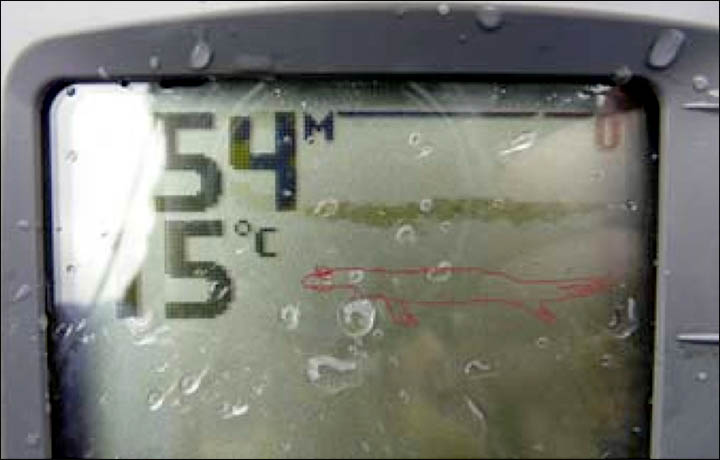
Echo sounding device data of the underwater object in lake Labynkyr, with
travelers drawing in red what they imagined the creature could have looked like.
Picture: veslo.ru
Some years ago Itogi magazine analysed the sightings and concluded:
'Comparing the stories we can say that it is 9-10 metres long, 1.2-1.5 metres
wide, its jaw is huge, up to one-third the size of its body, looking like a huge
beak with lots of teeth, and there is a sort of bone-made horn on the top of the
animal. The creature was met either in Labynkyr or in Vorota lake - locals
believe these lakes are connected to each other with the help of underground
passages.'
Grasping for mundane theories to explain what the creature might be - if not
a leftover from the Jurassic Age that somehow defied both extinction and the Ice
Age - some have suggested an abnormally huge and well-fed pike.
Yury Gerasimov, head of the Ichthyology Department of the Institute of
Biology of Freshwater of the Russian Academy of Sciences, is dubious. 'I have
never come across such a big pike and I highly doubt they can exist.
'If we trust the stories about this 'Devil', there must be about 1.5 metres
between its eyes. It means the length of its body must be about 7-8 metres.
'Pike do not live so long in order to reach such a big size. There are two
factors that help fish to grow - nutrition and comfortable water temperatures.
Even if nutrition is perfect there, surely the temperatures are not that high.
So in my opinion the view about a huge pike is a fantastic one.'
Another Russian traveller Sergei Karpukhin, a former geologist who once spent
35 days alone at Labynkyr, questions two basic premises of the
monster theory. If these monsters were to survive down
the ages, there must be sufficient of them to reproduce. There would also need
to be connections to other lakes, something he disputes.
'A little pack of them, like male/female plus several cubs is not enough,' he
said. 'To survive this population must have such a number of animals that the
lake would be swarming with them.
'Or at least there should be such number of them, that they would not go
unnoticed - given the description of them being quite big, and the lake is not
that large.
'I even think that there will need to be more creatures in the neighbouring
lakes which the Labynkyr ones can be in contact with. Only then they can
survive.
'Now the Labynkyr Devil defenders would, I know, refer to Lake Vorota, some
20 km away from Labynkyr. This is where Tverdokhlybov saw that mysterious
creature. Here the legend has some extra bits to it, that allegedly the lakes
are connected with some underground canals. I will argue this from a position of
a geologist: it is possible to have two connected lakes. BUT, when the lakes of
karstic origin. There must be some carbonaceous stones, which can be dissolved
by water.
'But there aren't any. The stones there are all volcanic.'

Soviet geologist Viktor Tverdokhlebov
Accounts began reaching the outside world after nine geologists led by Viktor
Tverdokhlebov, of the East Siberian branch of the Soviet Academy of Sciences,
were involved in an expedition to this remote corner of the then USSR in the
summer of 1953, a few months after the death of Stalin. As they rode on
horseback, their guide was the elderly Varfolomey Vinokurov, a local man.
It took eight years his diary account to be published in a Soviet magazine
and this referred to his own sighting in Lake Vorota - a name which literally
'Gates' (an unusual name for a lake, perhaps signifying Gates of the Devil?)
while also including historical accounts he heard from locals.
'30 May. We left Tomtor village, went 70 kilometres up
the Kuidusun Valley, turned left and got to the large Sordonnokhskoe plateau.
Ahead of us there is Lake Labynkyr where there is storage with food and
equipment.
'There are many legends about this Lake Labynkyr. In the evenings sitting
by the fire our old guide told us that a 'devil' lived in this lake. He is so
big that the distance between his eyes, as Varfolomey said, 'is wider than a
fisherman's raft made of ten logs'.
'I heard about this 'devil' before and many times. In Ust-Ner, I heard
that the devil ate a dog. The dog swam to bring the shot duck to the hunter,
then huge jaws raised from the water and the dog just disappeared in a
moment.
'One of the Tomtor villagers told me that one day he found a huge bone on
the shore of Lake Labynkyr. It was like the devil's jaw - if you put it
vertically, you could ride on a horse through it like under an arch. He said
this jaw bone remained near the fishermen house on the shore.
'I heard legends how a whole caravan perished going under the ice of
Labynkyr. It was spoken that people saw a big horn stuck out of the ice. People
gathered around it on ice and tried to take it out but suddenly the ice broke
and many people and reindeer died'.
'5 June: Early in the morning we got to the shore of
Lake Labynkyr and reached the storage. Comfortable tents with wooden beds and
floor and table awaited us.
'7 June: We are having a rest. Lake Labynkyr is a
square, 15 km long and 3 km wide. I found the ruined fisherman's house on the
shore, carefully explored the house and all around it but did not find any 'jaw
bone'.
He did not witness anything untoward in Labynkyr but went on with his
expedition.
28 July: Now we stopped at the shore of Lake Vorota.
Mikhail made a raft and went to measure the depth. It is 60 meters as in
Labynkyr. But the lake itself is much smaller.
30 July: This is what happened today. It was sunny
friendly morning, Boris Bashkatov and I went on a walking trip around Lake
Vorota. We had to climb rocks on the way - about 11 am the way became dangerous
and we decided to go down a bit, closer to the water. Looking at the water from
the rock, I clearly saw a terrace under the water with a huge white spot on it.
But when I looked at the terrace again a minute later there was no white spot
there. 'Maybe sunshine is joking with me', I thought. But suddenly Boris shouted
'Look! What is there, in the middle?' We stopped. Some 300-400 meters away on
the water there was clearly seen some white object, shining under the sunlight.
'A barrel', said Boris, 'made of tin.' 'Maybe a horse got into the lake,' I
said.
Truly, the object was swimming, and fast enough. It was something
alive, some animal. It was making an arch - first along the lake, then right
towards us. As it was getting closer, a strange coldness like a stupor was
growing inside me. Above the water there was big dark grey body, the white
colour has gone. On this dark grey background there were clearly visible two
symmetrical light spots looking like eyes and there was just stick in the body -
maybe a fin? Or a harpoon of an unlucky fisherman?
'We saw just a part of the animal but we could guess its much
bigger, massive body was under the water. We could guess this looking how the
monster was moving - raising from the water, it threw its body forward then
fully went under the water. At this time the waves were going away from its
head, waves originating under the water. 'Flapping its mouth, catching fish', I
guessed.
The animal was obviously swimming towards us and the waves made
by the animal reached our legs. We looked at each other and immediately began to
climb up the rock. What if 'it' goes out of the water? We witnessed a predator,
no doubt, one of the strongest predators in this world: such indomitable,
merciless and some sensible fierceness was in every his movement, in all its
looks.
'The animal stopped some 100 meters away from the shore. Suddenly
it began to beat against the water, waves went all ways, we could not understand
what was going on. Maybe it lasted just a minute and then the animal was gone,
dived. It was only then when I thought about a camera.
'We stood for another 10-20 minutes, it was quiet. We went
further.
'There was no doubt, we saw the 'devil' - the legendary monster
of this area. The Yakut fisherman was right, the animal had dark grey skin and
the distance between its eyes was surely not less than a raft of 10 logs. But he
saw it in Labynkyr and we saw it in Vorota lake. They are 20 km away from each
other - and they are not connected.
'I recalled that white spot under the water. Obviously, the
animal was hunting at that underwater terrace and we scared it when shouted
going down the rocks.'
There is, now, the possibility that the waters of the two lakes are connected
by a subterranean channel. For Tverdokhlebov, the sighting reminded him of the
killer whales he had seen in the Sea of Okhotsk.
'At first I thought it that this animal is an unknown offspring of extinct
animals who inhabited this area ages ago. But this feeling of fierceness was so
familiar to me - where could I see it?'
In 1945 he had a clone encounter with such a creature when swimming.
'We turned around and some 30 metres away in the water we saw a huge dark
grey body with two light spots and a fin above them. The animal was looking at
us as if it was choosing who to start with.'
He also heard more accounts from locals of 'monsters' in lakes
on this plateau, which some geologists say maybe of very recent formation. An
old fisherman told how he took his net out of Lake Yastrebiny and complaining it
was torn, he nodded his head and blamed some animal.
'I did not pay attention then, thinking it was just a big pike,' he
wrote.
'I recalled the stories of the workers who saw holes in the ice of Lake
Labynkyr and one day they saw some grey body through the hole which disappeared
later. Maybe all these stories are not that fantastic, and they are just a chain
of real events?
'But if we imagine it is a killer whale, how could it get here? The Sea of
Okhotsk is some 300 km away, and the plateau is 1 km above sea level. How would
the sea animal survive in fresh water? How did it get here? Is it alone here or
is there a whole family? What do they eat? How did they survive the Ice Age?
'What is obvious to me - the existence of this mysterious animal is closely
connected with the mystery of the plateau, how and when it appeared.'
His suggestion of a killer whale led to some ridicule for his account.
Cryptozoologist Valeriy Nikolayev scoffed: 'What killer whale? How on earth
would it get there, miles from sea?!'
'A group of such creatures stranded, perhaps, when this plateau was cut off from
the sea that has gone on reproducing in these remote parts? No, it's
impossible!'

Labynkyr lake, Yakutia. Pictures: Andrei Emelyanov
In a book 'Trip to the Cold Pole', author Gennady Borodulin recounts another
tale from Labynkyr in the 1920s.
'An Evenk family of nomads followed their reindeer and reached the shore of
Lake Labynkyr. They decided to stay overnight on the shore. A five year old
child went to the bank of a stream which led into the lake while adults were
busy. Suddenly the adults heard the boy screaming.
'The father and grandfather rushed to the bank. They stopped on the edge of
water and saw the child being carried away by an unknown animal to the centre of
the lake. It was a dark creature, with a mouth looking like bird's beak. It held
the child and moved away with quick rushes, then it dived leaving huge waves and
dragged the child under the water.
'The granddad swore to revenge the 'devil. He took a sack made of animal
skin, stuffed it with reindeer fur, rags, dry grass and pine trees needles, put
a smouldering piece of wood inside. He attached the sack to a huge stone on
shore with a rope and then threw the sack far into the waters of the lake.
'At night there was noise and splashes and terrible screams of the 'devil'.
In the morning the waves brought the huge dead animal, about seven meters long
with a huge jaw, almost one third size of the body, and relatively small legs
and fins.
'The old man cut the animal's stomach, took out the body of his grandson, and
buried him on the bank of the stream. Since then this stream is called 'The
Stream of a Child'.
'It is hard to say what happened to the remains of the animal but this jaw
was put like an arch on the shore.'
Could it have really happened? Only a fully fledged scientific mission can
hope to answer whether the Labynkyr Monster is myth or
reality.
At this point several details leaked to the Western press become clearer. The "Jaws and teeth" are more than likely mammoth skulls and ivory. There are two kinds of creatures generally reported in the area of Lakes Labynkir, Vorota and Baikhal: one a big fish about 5-6 feet wide and up to 20-30 feet long and most likely a sturgeon and not a pike (the arguments against an unusally large pike do not apply in that case). The other one is lizard-shaped and likely a giant salamander, 6-8 feet long at most. The two different types of sonar traces go to either one of them, but the longer one is distorted and vertically compressed somewhat, and the imaginary red outline does not help (The outline of the smaller animal, on the diagonal, is more likely and probably much nearer to the truth. It looks like a small labyrinthodont but could just as easily be a giant salamander.)-DD
Giant Salamander
Below, map of the (C) Chinese and (J) Japanese giant salamanders, indicating a suspected expanded range for the Chinese species (includes the area of Hong Kong and part of Siberia) and (?) the possible Eastern European population. Possible British population not indicated.
Swimming salamander in position to compare to sonar trace
(This one is shown from underneath, in an aquarium)
Known ranges of giant Sturgeon, also indicating that American white sturgeons could be related (a controversial idea which I happen to support) These are very large sturgeons with much shortened snouts. The Kaluga sturgeon also sports a full set of nail-like teeth
(also reported in similar water monsters said to live in inner Asia)
Lake monster reports from many areas outside the known ranges are described in terms which sound very like the known species. They are probably extensions in the range of the known species.




















